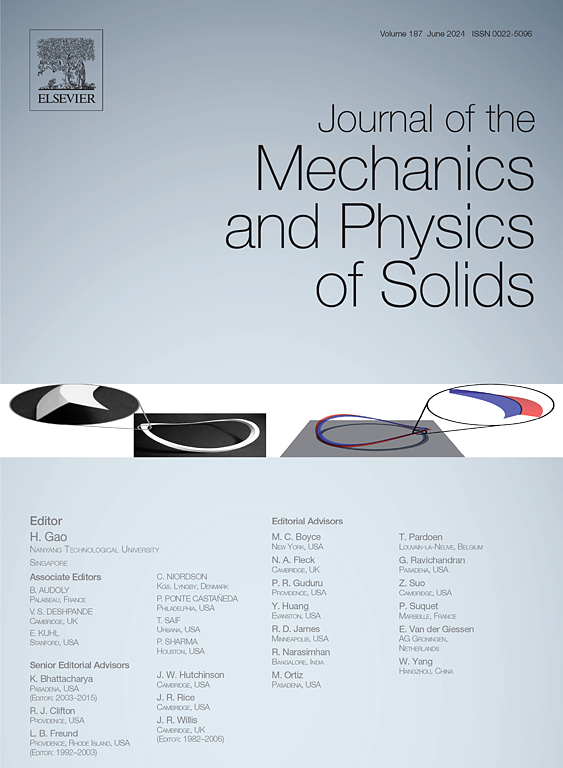光相互作用分子晶体的微观力学模型
IF 5
2区 工程技术
Q2 MATERIALS SCIENCE, MULTIDISCIPLINARY
引用次数: 0
摘要
分子晶体对光刺激的反应是弯曲、扭曲、滚动、跳跃或其他运动行为。众所周知,这些行为受到入射光强度、晶体几何形状的纵横比以及伴随相变的体积变化等因素的影响。虽然这些因素单独解释了系统内能的增加及其随后通过宏观变形的最小化,但它们并不能完全解释在分子晶体中观察到的变形的多样性。在此,我们提出了一个基于柯西-玻恩规则和光反应理论的微观力学模型来预测分子晶体中的宏观反应。通过考虑相变过程中出现的晶格几何变化和微观结构模式,我们预测了具有代表性的分子晶体(水杨柳二胺)的一系列变形。通过这样做,我们发现光激发态和能量最小化路径之间的相互作用,在多井能量景观中,对弯曲和扭转变形至关重要。我们使用我们的模型来分析颗粒几何形状和入射光强度对宏观变形的作用,并确定水杨柳二胺晶体中剪切和扭转变形的几何机制。我们的微力学模型是通用的,可以用于预测其他分子晶体在固-固相变过程中的光力学变形,并且有潜力作为计算设计工具来设计分子晶体的可逆和可控驱动。本文章由计算机程序翻译,如有差异,请以英文原文为准。
A micromechanical model for light-interactive molecular crystals
Molecular crystals respond to a light stimulus by bending, twisting, rolling, jumping, or other kinematic behaviors. These behaviors are known to be affected by, among others, the intensity of the incident light, the aspect ratios of crystal geometries, and the volume changes accompanying phase transformation. While these factors, individually, explain the increase in internal energy of the system and its subsequent minimization through macroscopic deformation, they do not fully explain the diversity of deformations observed in molecular crystals. Here, we propose a micromechanical model based on the Cauchy–Born rule and photoreaction theory to predict the macroscopic response in molecular crystals. By accounting for lattice geometry changes and microstructural patterns that emerge during phase transformation, we predict a range of deformations in a representative molecular crystal (salicylideneamine). Doing so, we find that the interplay between photoexcited states and the energy minimization pathways, across a multi-well energy landscape, is crucial to the bending and twisting deformations. We use our model to analyze the role of particle geometries and the intensity of incident light on macroscopic deformation, and identify geometric regimes for shearing and twisting deformations in salicylideneamine crystals. Our micromechanical model is general and can be adapted to predict photomechanical deformation in other molecular crystals undergoing a solid-to-solid phase change and has potential as a computational design tool to engineer reversible and controllable actuation in molecular crystals.
求助全文
通过发布文献求助,成功后即可免费获取论文全文。
去求助
来源期刊
CiteScore
9.80
自引率
9.40%
发文量
276
审稿时长
52 days
期刊介绍:
The aim of Journal of The Mechanics and Physics of Solids is to publish research of the highest quality and of lasting significance on the mechanics of solids. The scope is broad, from fundamental concepts in mechanics to the analysis of novel phenomena and applications. Solids are interpreted broadly to include both hard and soft materials as well as natural and synthetic structures. The approach can be theoretical, experimental or computational.This research activity sits within engineering science and the allied areas of applied mathematics, materials science, bio-mechanics, applied physics, and geophysics.
The Journal was founded in 1952 by Rodney Hill, who was its Editor-in-Chief until 1968. The topics of interest to the Journal evolve with developments in the subject but its basic ethos remains the same: to publish research of the highest quality relating to the mechanics of solids. Thus, emphasis is placed on the development of fundamental concepts of mechanics and novel applications of these concepts based on theoretical, experimental or computational approaches, drawing upon the various branches of engineering science and the allied areas within applied mathematics, materials science, structural engineering, applied physics, and geophysics.
The main purpose of the Journal is to foster scientific understanding of the processes of deformation and mechanical failure of all solid materials, both technological and natural, and the connections between these processes and their underlying physical mechanisms. In this sense, the content of the Journal should reflect the current state of the discipline in analysis, experimental observation, and numerical simulation. In the interest of achieving this goal, authors are encouraged to consider the significance of their contributions for the field of mechanics and the implications of their results, in addition to describing the details of their work.

 求助内容:
求助内容: 应助结果提醒方式:
应助结果提醒方式:


